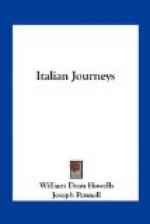Returning to the city we visited the house of Giulio Romano, which stands in one of the fine, lonesome streets, and at the outside of which we looked. The artist designed it himself; and it is very pretty, with delicacy of feeling in the fine stucco ornamentation, but is not otherwise interesting.
We passed it, continuing our way toward the Arsenal, near which we had seen the women at work washing the linen coats of the garrison in the twilight of the evening before; and we now saw them again from the bridge, on which we paused to look at a picturesque bit of modern life in Mantua. The washing-machine (when the successful instrument is invented) may do its work as well, but not so charmingly, as these Mantuan girls did. They washed the linen in a clear, swift-running stream, diverted from the dam of the Mincio to furnish mill-power within the city wall; and we could look down the watercourse past old arcades of masonry half submerged in it, past pleasant angles of houses and a lazy mill-wheel turning slowly, slowly, till our view ended in the gallery of a time-worn palace, through the columns of which was seen the blue sky. Under the bridge the stream ran very strong and lucid, over long, green, undulating water-grasses, which it loved to dimple over and play with. On the right were the laundresses under the eaves of a wooden shed, each kneeling, as their custom is, in a three-sided box, and leaning forward over the washboard that sloped down into the water. As they washed they held the linen in one hand, and rubbed it with the other; then heaped it into a mass upon the board and beat it with great two-handed blows of




